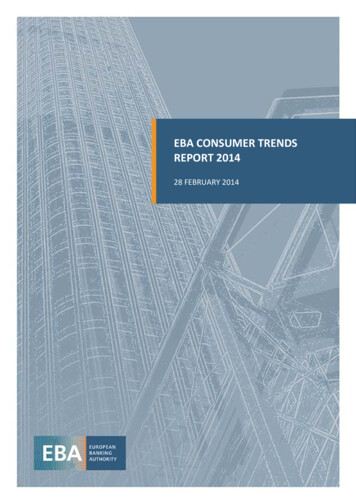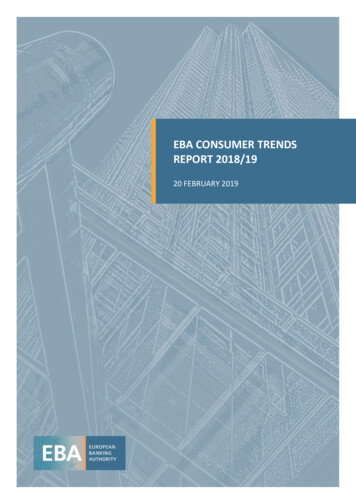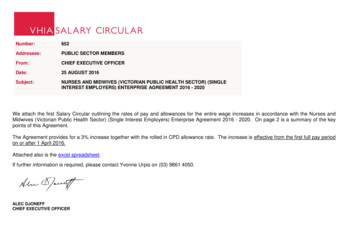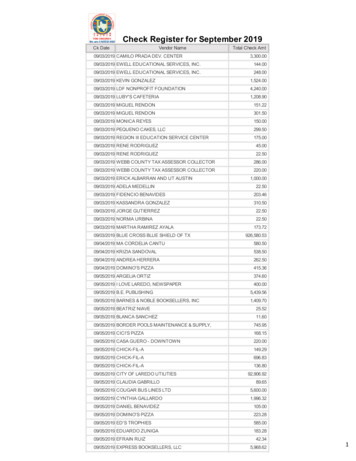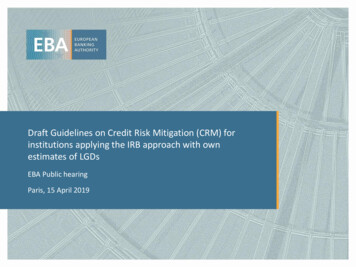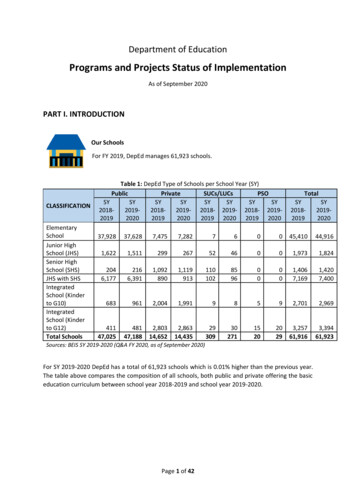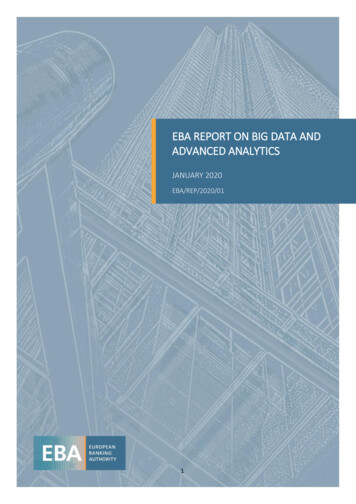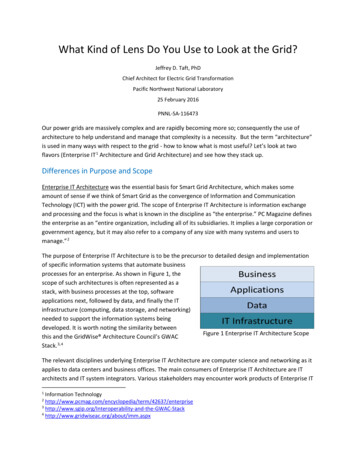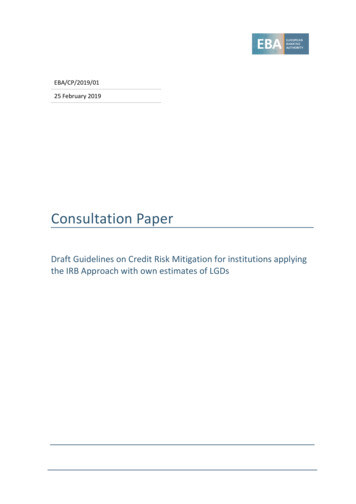
Transcription
EBA/CP/2019/0125 February 2019Consultation PaperDraft Guidelines on Credit Risk Mitigation for institutions applyingthe IRB Approach with own estimates of LGDs
CONSULTATION PAPER ON GL ON CREDIT RISK MITIGATIONContents1. Responding to this consultation32. Executive Summary43. Background and rationale54. Draft Guidelines255. Accompanying documents495.1Draft cost-benefit analysis / impact assessment495.2Overview of questions for consultation592
CONSULTATION PAPER ON GL ON CREDIT RISK MITIGATION1. Responding to this consultationThe EBA invites comments on all proposals put forward in this paper and in particular on the specificquestions summarised in Section 5.2.Comments are most helpful if they: respond to the question stated;indicate the specific point to which a comment relates;contain a clear rationale;provide evidence to support the views expressed/ rationale proposed; anddescribe any alternative regulatory choices the EBA should consider.Submission of responsesTo submit your comments, click on the ‘send your comments’ button on the consultation pageby 25 May 2019. Please note that comments submitted after this deadline, or submitted via othermeans may not be processed.Publication of responsesPlease clearly indicate in the consultation form if you wish your comments to be disclosed or tobe treated as confidential. A confidential response may be requested from us in accordance withthe EBA’s rules on public access to documents. We may consult you if we receive such a request.Any decision we make not to disclose the response is reviewable by the EBA’s Board of Appealand the European Ombudsman.Data protectionThe protection of individuals with regard to the processing of personal data by the EBA is basedon Regulation (EC) N 45/2001 of the European Parliament and of the Council of 18 December2000 as implemented by the EBA in its implementing rules adopted by its Management Board.Further information on data protection can be found under the Legal notice section of the EBAwebsite.3
CONSULTATION PAPER ON GL ON CREDIT RISK MITIGATION2. Executive SummaryThe EBA review of the IRB approach overall aims to reduce unjustified variability stemming fromdifferent supervisory and bank-specific practices, while preserving the higher risk sensitivityassociated with internal models. The credit risk mitigation framework (CRM) is an integral part ofIRB framework and consequently the application of CRM methods can be a source of variability.These draft guidelines presented in this consultation aims to clarify the credit risk mitigationframework in the context of the Advanced IRB Approach (A-IRB). They thereby complement theEBA report on the credit risk mitigation framework, which was focused on the StandardisedApproach and the Foundation IRB Approach.The industry, as well as EBA in previous work, have identified a clear need for these guidelines. TheEBA and the industry have flagged that the complexity of the current CRR provisions on the creditrisk mitigation framework due to numerous references and cross-references raises a significantnumber of implementation issues. The abovementioned EBA report provided some clarity on theapplication of the CRM framework in the context of SA and F-IRB, but the analysis carried out bythe EBA in the context of the EBA report on credit risk mitigation framework also noted the limitedguidance provided in the current CRR provisions on CRM under the Advanced-IRB Approach (AIRB).Consequently, the Guidelines provide additional clarity on the application of the CRM approach forA-IRB institutions. These draft guidelines are therefore focused on clarifying the application of thecurrent CRR provisions for the eligibility and methods of different credit risk mitigation techniques,namely funded and unfunded credit protection, available to institutions under the Advance-IRBApproach. This is supplemented by additional detailed guidance on eligibility requirements andtreatment of funded and unfunded credit protection. It is the EBA’s belief that these draftGuidelines should help eliminate the unwarranted differences in approaches remaining in the areaof CRM due to either different supervisory practices or bank-specific choices.Next stepsThe draft guidelines are published for the 3 months consultation period. At the same time, the EBAis currently working on the Call for Advice on the impact of the final Basel III framework whichincludes in the scope also revisions on some specific aspects of the credit risk mitigation framework.Some parts of the CRM framework which is envisaged to change in the Basel III framework istherefore considered in the context of the Call for Advice. In addition, the responses received duringthe consultation period, as well as the conclusions and the results of the qualitative survey on issuesrelated to credit risk mitigation analysed in the context of the Call for Advice, will be taken intoaccount when specifying the final guidelines.4
CONSULTATION PAPER ON GLS ON CREDIT RISK MITIGATION3. Background and rationale3.1 Introduction1. The European Banking Authority (EBA) has previously outlined its work program on the reviewof the IRB Approach in EBA’s Opinion on the IRB Approach 1. After i) reviewing supervisorypractices; ii) harmonising the definition of default; and iii) providing more clarity on how tomodel probability of default (PD), loss given default (LGD) and defaulted exposures, includingthe estimation of downturn LGD. These draft guidelines (GL) constitute as the fourth phase ofthis work program, although these Guidelines were not originally envisaged as part of the EBAreview, and aim to clarify the credit risk mitigation (CRM) framework in the context of theAdvanced IRB Approach (A-IRB).2 They thereby complement the EBA report on the credit riskmitigation framework 3 (hereinafter ‘CRM report’), which was focused on StandardisedApproach (SA) and Foundation IRB Approach (F-IRB).2. In accordance with Article 108 of Regulation (EU) No 575/2013 (hereinafter ‘CRR’), forexposures to which an institution applies the SA or F-IRB, the institution may use CRM inaccordance with Part Three, Title II, Chapter 4 of the CRR (hereinafter ‘Chapter 4’) in thecalculation of risk-weighted exposure amounts (RWEA). For exposures to which an institutionapplies the IRB approach with own estimates of LGDs and conversion factors, i.e. exposuresunder A-IRB, the institution may use CRM in accordance with Part Three, Title II, Chapter 3 ofthe CR (hereinafter ‘Chapter 3’). Due to these different requirements for the SA and F-IRB onthe one hand and for the A-IRB on the other hand, the requirements for the use of CRM haveto be considered separately. In particular, an overview of the CRM techniques and methodsavailable under Chapter 4 and used under the SA, under the Supervisory Slotting CriteriaApproach (SSCA) and under the F-IRB is already provided in the CRM report. These draft GL1Please refer to the following Opinion: EBA-Op-201601 Opinion on IRB /www.eba.europa.eu/documents/10180/1360107/EBA Report on the regulatory review of the IRB Approach.pdf2As clarified in the CRM report the Basel capital framework refers, for non-retail exposures, to Foundation IRBA (F-IRBA),i.e. where institutions provide their own PD estimates and rely on regulatory parameters for the other risk components(LGD and credit conversion factors (CCFs)). In contrast, under the Advanced IRBA (A-IRBA) institutions provide not onlytheir own estimates of PD, but also of LGDs and CCFs for estimating the exposure value for off-balance sheet (OBS) items,subject to meeting minimum requirements, and calculate the remaining effective maturity where permitted. The CRRhowever does not explicitly refer to F-IRBA or A-IRBA, but instead talks of the IRB Approach where institutions have thepermission to use their own estimates of LGD and conversion factors. The latter differs from A-IRBA, commonly referredto in the Basel capital framework because it also includes retail exposures (for which own estimates of LGDs and CCFs aremandatory, either as direct estimates or, for LGDs, derived from an estimate of expected losses and an own estimates ofPD). These drafts GL refer to the terms used under the CRR with relevant acronyms where appropriate for consistencyand to avoid misunderstandings. Therefore, these GL use the term A-IRB to refer to IRB Approach with own estimates ofLGDs and CCFs and F-IRB to the IRB Approach without own estimates of LGD and 9/EBA Report on CRM framework.pdf5
CONSULTATION PAPER ON GLS ON CREDIT RISK MITIGATIONcomplement this work by providing guidance on the CRM provisions on eligibility and methodsavailable under Chapter 3 and used under the A-IRB.3. Increased clarity of the CRM framework is considered an integral part of the IRB review andreflects the feedback received from the stakeholders to the Discussion Paper on ‘The Future ofthe IRB Approach’ published on the 4 March 2015. One of the main takeaways from theconsultation was that, while the EBA had been given mandates to develop technical standardson selected issues4, there was an overall need to consider the functioning of CRM frameworkas a whole. More specifically, industry flagged the complexity of the current CRR provisions dueto numerous references and cross-references that make it difficult to understand whichprovision applies under which approach to credit risk.4. In the case of the A-IRB, some clarifications on the use of CRM have already been provided inthe EBA GL on the PD estimation, LGD estimation and the treatment of defaulted exposures(hereinafter ‘EBA GL on PD and LGD estimation’) published in November 2017 as part of theguidance for the LGD estimation.5 However, there are still certain outstanding issues, whichhave not been addressed by these draft GL and where different interpretations and practicesare observed.5. At the same time, the recent changes introduced through the final Basel III framework6 shouldto the extent possible also be taken into account. Indeed, on 4 May 2018 the EBA has receivedfrom the European Commission a Call for Advice (CfA) on the impact and implementation ofthe final Basel III framework. The revisions in the scope of the CfA include the revised standardsin the areas of credit risk and, in particular, on some specific aspects of the CRM framework. Inthis context, any issue which may lead to inconsistencies with respect to the current CRR rulesor, alternatively, to a deviation from the final Basel III framework are currently discussed in thecontext of the CfA and therefore not included in these draft GL.6. With a view to support an implementation of the legislation which is clear and consistent acrossinstitutions and jurisdictions, these draft GL are therefore clarifying the application of currentCRR provisions regarding CRM under the A-IRB and should help eliminate the unwarranteddifferences in approaches remaining in the area of CRM either due to different supervisorypractices or institution-specific choices.7. These draft GL are structured in three main parts: i) a section general provisions (Section 4)which aims at providing clarity on the application of the CRM provisions of Chapter 3 of thecurrent CRR; iii) a section providing guidance on eligibility requirements for both the so-called4The mandates included in the CRR for the EBA to develop technical standards in the area of CRM are only focused on afew selected aspects of the CRM framework and, in particular, include: 1) RTS under Article 183(6) of the CRR on therecognition of conditional guarantees; 2) RTS under Article 194(10) of the CRR on liquid assets and 3) RTS under Article221(9) of the CRR on the Internal Models Approach for master netting 180/2033363/Guidelines on PD and LGD estimation 1d26493ed06Text of the final Basel III framework (Dec 2017): Basel III: Finalising post-crisis reforms.6
CONSULTATION PAPER ON GLS ON CREDIT RISK MITIGATIONfunded credit protection (FCP) and unfunded credit protection (UFCP) (Section 5); and iii) asection on the treatment of FCP and UFCP (Section 6).3.2 General provisions8. While a detailed explanation of the CRM techniques available for exposures under SA and F-IRBhas already been provided in the EBA Report on CRM (Section 2.2) this section focuses oncarrying out a mapping of the articles in Chapter 3 of the CRR detailing the provisions for theeligibility and methods of CRM at institutions’ disposal for exposures under A-IRB. The aim ofthis mapping is to shed light on the CRM framework as provided in the CRR, as stakeholdershave raised concerns regarding the clarity of the framework as it currently stands.9. As clarified in paragraph 2 above, the CRR defines the scope of application of the CRMframework in Article 108 of the CRR. In particular, for exposures to which an institution appliesthe SA and F-IRB the CRM techniques may be recognised in accordance with Chapter 4, whereasfor exposures to which an institution applies the A-IRB the CRM techniques may be recognisedaccording to Chapter 3.10. In this respect, the first general clarification is provided in paragraph 11 of these draft GL andstates that the requirements of Chapter 4 only apply is to exposures treated under A-IRB whereexplicitly cross-referenced in Chapter 3. A-IRB institutions therefore apply Chapter 3 and, inparticular (as also clarified in Figure 1):Figure 1: CRM techniques and methods under Chapter 3 of the CRRCRM techniquesFunded Credit Protection (FCP)Through exposure Valuefor Master nettingagreement (MNA) andon-balance sheet netting(OBSN):in accordance withArticles 166(2)-(3) andChapter 4 of the CRR Through LGDAdjustments for FCPother than MNA andOBSN :in accordance withArticles 181(1)(c)-(g) ofthe CRRUnfunded Credit Protection (UFCP)Through PD and/or LGDAdjustmentsin accordance with Articles160(5), 163(4), 161(3), 164(2)and 183(1)-(3) of the CRRThrough "doubledefault" formulain accordance withArticles 153(3) and154(2) of the CRRparagraph 14 of the draft GL: Article 166(2) and (3) of the CRR regulate that institutions mayrecognise the effects of master netting agreements (MNA) and on-balance sheet netting(OBSN) respectively through modifications of the exposure value; in this respect, these draftGL clarify that the CRM effects of such techniques may be recognised only throughadjustment of the exposure value and that institutions should hence take into account allthe requirements of Chapter 4, including eligibility requirements and methods;7
CONSULTATION PAPER ON GLS ON CREDIT RISK MITIGATION paragraph 13 of the draft GL: Article 181(1) letters (c) to (g) of the CRR regulate thatinstitutions may recognise the effects of FCP other than MNA and OBSN in their LGDestimates; in this context, it is clarified that for the purposes of estimating LGD according toArticle 181(1) letters (c) to (g) of the CRR, the references to ‘collateral’ should be understoodas references to FCP other than MNA and OBSN, that are already recognised in the exposurevalue in accordance with Article 166 (2) and (3) of the CRR. The term ‘collateral’ is notdefined in the CRR whereas only FCP and UFCP are defined in Article 4(1), points (58) and(59) of the CRR. According to the provided definitions and also consistently with the stancesincluded in the CRM report, the fundamental difference between the two types of creditprotection lies in the type of risk the protection receiver is exposed to: in the case of FCP,the lending institution bears the risk that the collateral received deteriorates in value,thereby resulting in a lower protection, while in the case of UFCP, the lending institutionbears the risk that the protection provider is not able to pay upon default of the obligor;moreover, since the CRM effects of OBSN and MNA should be recognised throughadjustments to the exposure value rather than to the LGD they are also considered out ofthe scope of application of Article 181(1) of the CRR on own estimates of LGDs; the abovementioned considerations justify the “narrow” interpretation of the term collateral asreferring to FCP other than netting only; paragraph 12 of the draft GL: Articles 160(5) and 163(4) of the CRR regulate that institutionsmay recognise the effects of UFCP by adjusting the PDs subject to Article 161(3) and 164(2)of the CRR respectively. These articles clarify that UFCP may be recognised by adjusting PDor LGD estimates in accordance with Article 183 (2) and (3) of the CRR and under theconstraint that the resulting adjusted risk weight should not be lower than the risk weightthat the institution would assign to a comparable, direct exposure to the guarantor7 (the socalled “risk weight floor”); alternatively, institutions may recognise the effects of UFCP inaccordance with Articles 153(3) and 154(2) of the CRR, the so-called “double default (DD)”formula (applicable to exposures both under the F-IRB and the A-IRB), where therequirements under Articles 202 and 217 of the CRR are met. In this respect, Article 161(4)and 164(3) of the CRR provide clarifications on the LGD to be used in the DD formulaprovided by Article 153(3) of the CRR. In particular, it is clarified that the recognition of UFCPin accordance with Articles 160(4) and 161(1)(c) of the CRR, is applicable only whereinstitutions use the F-IRB and are therefore out of the scope of these draft GL.11. An additional clarification provided in paragraph 15 of the draft GL relates to the treatment ofcredit insurance. In particular, focusing on the economic substance of the financial agreement,in accordance with the CRM report (paragraph 36) and the Q&A 2014 7688, it is clarified thatin the context of A-IRB credit insurance may be recognised as a guarantee (or a creditderivative) where it effectively functions in an equivalent manner. Since the CRR does not give7It should be noted that in line with the CRR wording the terms 'guarantor' and 'guarantee' is sometimes used to includeboth guarantees in the strict sense as well as credit derivatives and, therefore, as a synonym of protection provider andUFCP respectively. In this respect, for example, the reference to comparable, direct exposures to guarantor should beunderstood as reference to comparable direct, exposures to protection provider.8This Q&A (link) specifies that credit insurance can qualify as a guarantee, but that this depends on the circumstances ofthe individual case and on the intrinsic characteristics of the contract and its economic substance.8
CONSULTATION PAPER ON GLS ON CREDIT RISK MITIGATIONa definition of guarantees or credit derivatives, it is furthermore clarified that in order toconsider credit insurance equivalent to UFCP, and therefore requiring the same eligibility andadjustment criteria for UFCP as included in Article 183 (1) to (3) of the CRR, the credit insurancehas to meet the UFCP definition given in Article 4(1), point (59) of the CRR. In particular, whatspecific point of Article 183 of the CRR should apply (i.e. points (1) and (2) for guarantees orpoint (3) for credit derivatives) will depend on the substance of the contract, i.e. whether itworks more like a guarantee or like a credit derivative.3.3 Eligibility requirements12. For exposures to which institutions apply the A-IRB, the CRR specifies the eligibilityrequirements for (i) FCP (other than MNA and OBSN) in Article 181(1)(f) and (ii) UFCP in Article183(1). The rationale behind both articles is to ensure that A-IRB institutions meet the minimumrequirements for the eligibility of the protection while at the same time adhering to thehierarchy of the approaches. This means that under the A-IRB institutions have the possibilityto reflect in their estimates protection of lower quality, while under F-IRB and SA only highquality protection may be recognised. Under the SA and F-IRB, the eligibility requirements ofChapter 4 are very restrictive, limiting the mitigation mechanism of UFCP to the substitution ofrisk weights or PDs, respectively. Under the A-IRB, risk sensitivity is enhanced through thebroader eligibility of CRM techniques provided that institutions can adequately reflect thelowered efficiency of instruments not eligible under SA and F-IRB in the PD or LGD estimates.3.3.1Eligibility requirements for funded credit protection (FCP)13. With regard to FCP (other than OBSN and MNA), Article 181(1)(f) of the CRR establishes that ifcollateral is taken into account in the LGD estimation institutions should set internalrequirements for collateral management, legal certainty and risk management which are‘generally consistent with those set out in Chapter 4, Section 3’. The lack of guidance on theconcept of ‘general consistency’ is an issue that has been highlighted by the industry as beinga source of uncertainty and variability in the application of the CRR provisions with respect toCRM for A-IRB exposures. Some clarification has already been provided in Article 55 of the Finaldraft Regulatory Technical Standard on the specification of the assessment methodology forcompetent authorities regarding compliance of an institution with the requirements to use theIRB Approach in accordance with Articles 144(2), 173(3) and 180(3)(b) of Regulation (EU) No575/2013 (hereinafter ‘ RTS on AM’) 9 , not adopted by the European Commission, whichspecifies that for the purposes of Article 181(1)(f) of the CRR, general consistency should beunderstood as, or would be fulfilled by, full consistency with the requirements for collateralvaluation and legal certainty. In other words, if the institution’s requirements are fullyconsistent with the ones specified in Chapter 4, Section 3 of the CRR for collateral valuation andlegal certainty, this would ensure to meet the general consistency requirement of Article181(1)(f) of the /Final Draft RTS on Assessment Methodology for IRB.pdf/e8373cbc-cc4b-4dd9-83b5-93c9657a39f09
CONSULTATION PAPER ON GLS ON CREDIT RISK MITIGATION14. Moreover, an implication of Article 181(1)(f) of the CRR is that institutions should provideinternal requirements for collateral management, legal certainty and risk management whichare generally consistent with the ones provided in Chapter 4, Section 3, for any collateralagreement taken into account in the LGD estimation and not only for those listed in Chapter 4,Section 3.15. These draft GL therefore provide the following two clarifications:(i) General eligibility principles on legal certainty and collateral valuation, respectively inparagraphs 16 and 17 of these draft GL, applicable to all collaterals used for the purpose ofLGD estimation. In other words these principles form a minimum set of eligibilityrequirements that is meant to ensure that all collateral types, even those that are notexplicitly included in any of the broad categories described in Chapter 4, Section 3, aresubject to the assessment of legal certainty and collateral valuation. In particular:a. In terms of general principles on legal certainty applicable to all collateral used inLGD estimation, it is proposed that for exposures under the A-IRB institutionsestablish internal requirements which ensure that the collateral agreement is legallyeffective and enforceable, i.e. ensuring the power of the creditor to enforce therealisation of the collateral; it should further be ensured that the institution has theright to liquidate or take legal possession of the collateral even in the event of thebankruptcy or insolvency of the obligor and, where applicable, of the custodianholding the collateral on behalf of the obligor; this enforced liquidation orrepossession of collateral should be possible in a “reasonable timeframe” withrespect to the market and legal environment in a relevant jurisdiction;b. in terms of general principles on collateral valuation applicable to all collateral usedin the LGD estimation, it is proposed that for exposures under the A-IRB institutionsestablish internal requirements which ensure that the rules governing therevaluation of the collateral, including methods and frequency of the monitoring ofthe value of the collateral, are consistent with the type of collateral taken intoaccount in their LGD estimates and are specified in the internal policies of theinstitution; moreover, more frequent monitoring should be carried out by theinstitutions where the market is subject to significant changes in conditions.(ii) A mapping of Chapter 4, Section 3 of the CRR to legal certainty and collateral valuation tailormade for a subset of broad categories of collateral which A-IRB institutions should considerin satisfying the requirement of full consistency of Article 55 of the RTS on AM and,consequently, in satisfying the requirements of general consistency of Article 181(1)(f) ofthe CRR. The proposed mapping is presented in paragraph 18 of the draft GL and providesthe minimum criteria to meet the general consistency criteria mentioned in Article 181(1)(f)of the CRR. It is worth noting that the general principles provided are based on the eligibilityrequirements of Chapter 4, Section 3. This implies that full compliance with the legalcertainty and collateral valuation requirements of Chapter 4, section 3, for those collaterals10
CONSULTATION PAPER ON GLS ON CREDIT RISK MITIGATIONthat are included in one of the broad categories presented in that section, would ensurealso compliance with these general principles. The draft GL do not provide any specificmapping for risk management requirement.16. Finally, notwithstanding the non-applicability of Article 194 of the CRR to A-IRB exposures,10the draft GL clarify in paragraph 19 that in order to verify the legal certainty requirements forFCP the institutions should obtain a legal opinion confirming the legal effectiveness (i.e. the factthat the collateral arrangement is valid and binding) and enforceability of the FCP in all relevantjurisdictions. In particular, it is clarified that this legal opinion should be obtained by theinstitution at least for each type of collateral arrangement rather than for each specificcollateral arrangement. Where a single legal opinion is issued for multiple collateralarrangements, that legal opinion must relate to the same applicable law and must be in relationto the same obligor. Moreover, the guidelines specify that it should be provided in written formby a legal counsel who is independent (i.e. not directly benefiting) from the credit decisionprocess responsible for originating or renewing the exposures under considerations.17.Identifying the relevant jurisdictions for other physical collateral and lease exposures treated ascollateralised that are movable but not in the possession or in the control of the creditor, suchas car and ships, may be challenging for institutions especially if a point in time evaluation of therelevant jurisdiction using the location of the collateral is requested. By their intrinsic nature,these goods can be located in any jurisdictions because they can easily be moved around and(despite the ownership in the case of leasing) they are not in the control of the creditors.Therefore, a legal certainty assessment throughout all the jurisdictions where the goods are orcould be located would be challenging and overly burdensome. In this respect, the draft GLclarify the minimum set of jurisdictions which should be considered relevant when performingthe legal certainty assessment (i.e. the assessment of the collateral arrangement effectivenessand enforceability) for other physical collateral that are movable and not in the possession ofthe creditor (paragraph 20) and for leasing exposures considered as collateralised that aremovable and not in the control of the creditor (paragraph 21). In particular, among this minimumset of relevant jurisdictions institutions should consider, the set of jurisdictions where thecollateral could move during the lifetime of the loan as specified in the collateral arrangement.Softer alternatives have also been considered such as to evaluate the jurisdiction where thecollateral is usually located for the purpose of its use.3.3.2Eligibility requirements for unfunded credit protection (UFCP)18. With regard to UFCP, Article 183(1)(c) of the CRR establishes legal certainty requirements forthe assessment of guarantees and credit derivatives. In particular, it requires that theguarantee11 is: (i) documented in writing; (ii) non-cancellable on the part of the guarantor; (iii)in force until the obligation is satisfied in full; (iv) legally enforceable against the guarantor.10Which requires institutions to obtain an “independent, written and reasoned” legal opinion confirming that the creditprotection is “legally effective and enforceable in all relevant jurisdictions”.11As clarified before, in line with the CRR wording of Article 183(1), the term 'guarantee' is here used to include bothguarantees in the strict sense as well as credit derivatives.11
CONSULTATION PAPER ON GLS ON CREDIT RISK MITIGATIONThese requirements aim at ensuring that the guarantees are binding on all parties (i.e. legallyeffective) and that the creditor has the power to enforce its judgment (i.e. legally enforceable).In addition, Article 183(1) letters (a) and (b) of the CRR provides rules related to the “eligibleguarantor”.19. Consistently with the guidance provided for FCP, the draft GL clarify in paragraph 23 that inorder to verify the legal certainty requirements for UFCP the institutions should obtain a legalopinion confirming the legal effectiveness (i.e. the fact that the UFCP arrangement is valid andbinding) and enforceability of the UFCP in all relevant jurisdictions as required in Article183(1)(c) of the CRR. In particular, it clarifies that this
review, and aim to clarify the credit risk mitigation (CRM) framework in the context of the Advanced IRB Approach (A-IRB).2 They thereby complement the EBA report on the credit risk mitigation framework 3 (hereinafter 'CRM report'), which was focused on Standardised Approach (SA) and Foundation IRB Approach (F-IRB). 2.
